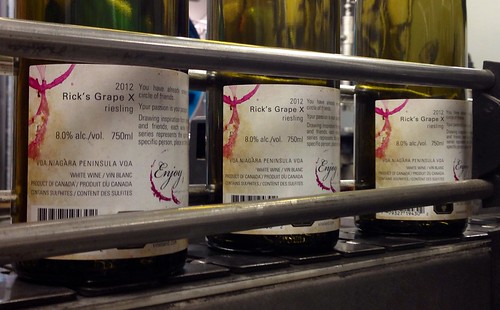
Intro: It’s not always the wine that excites me, it’s the journey it takes to get in my glass from vine, to bud, to flower to grape to harvest, to crusher, to fermentation, to barrel, to bottle and finally in my mouth.
We take the journey lightly, letting Mother Nature, viticulturists and winemakers do all the work before we show any interest in the life of a grape. After all, it’s not one grape we’re interested in it’s a whole bunch of them.
I have always wanted to patiently watch a single bud as it grows into a grape through various stages it takes before it’s gone in a gulp. I know, I know, how geeky is that, right? Well, it’s really geeky, and I admit it. And frankly, I didn’t have time to sit and watch a grape grow.
But I do have friends. Friends who know how this stuff works. They agreed to be co-conspirators in helping to explain the journey of vine to grape.
For this adventure, something I’m calling the Grape Chronicles, I chose one of Niagara’s historic vineyards to find my little grape we called Grape X as we followed it through its life cycle this past fall.

It’s here in Niagara’s St. Urban Vineyard at Vineland Estate, the famed Riesling Mecca that is presided over by winemaker Brian Schmidt and viticulturist Roman Prydatkewycz, that we chose a vine that yielded our grape.
This is the story of Grape X. And, it should be noted, that I followed this grape through the 2012 growing season and wrote a diary of its progress on this site while Grape X made its journey. This story originally ran in Tidings Magazine (now Quench) and in other publications. I am re-publishing this story with an epilogue as the wine as now been bottled and ship to Vineland Estate wine club members.
•••
A Grape is Born

As far as anyone can tell exactly, Grape X was born on May 14, 2012. And she died on September 22 of the same year. Grape X lived a short but noble life, and made the ultimate sacrifice for the enjoyment of others.
She was born, raised and spent her entire life at Vineland Estate, in the first row of the St. Urban Vineyard’s Field D, the 10th post in, the second vine. It was marked with a special plaque until the very end.
Even before Grape X was actually a grape, preparations were being made for her arrival into the world.
Pruning in the vineyard took place in February of 2012. The vines were in a dormant state from the moment the leaves dropped in late fall of 2011 until early spring. The pruners leave extra shoots on the vines and the health of the buds, usually 10-12 buds per shoot, determine which two shoots will be left to tie off on the trellis system. The Pendlebogen trellising system is used in the St. Urban Vineyard, with shoots tied horizontally. Spacing is 4.5 feet between vines and nine feet between the rows. The Pendlebogen trellis system helps with arching of canes and creates better vertical distribution of fruit on the trellis.
Vineland Estate viticulturist Roman Prydatkewycz noted that the 2012 vintage was about two weeks ahead of normal and nearly four weeks ahead of the 2011 vintage. The most important factor determining bud break, the first stage in a grape’s life, Prydatkewycz said, is the ground temperature, which needs to warm up to about 15C. “Everything depends on the root system,” he said.
We Have Bud Break!

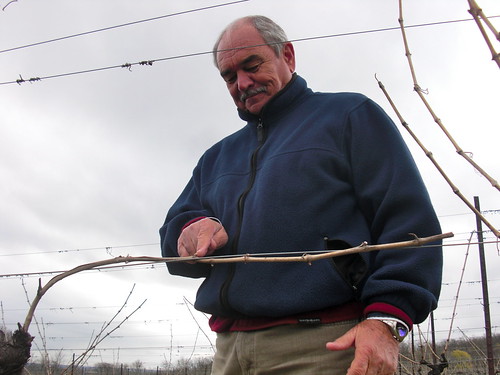
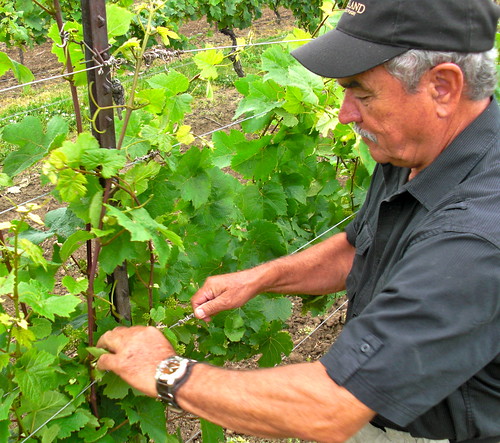
It wasn’t an easy ride, but in early May bud break finally occurred in Niagara.
There were some very scary moments that could have been catastrophic for grape growers, but, despite all that, another blessed milestone was achieved in mid-May in the evolution of Grape X.
An extremely hot early spring, followed by at least two nail biting below zero nights in late April, kept wine growers on pins and needles, and, in some cases, on speed dial to the local helicopter company, to deal with the threat of frost.
But sure enough, by May 14, nature followed its path and bud break occurred at wineries across Niagara.
A lot had happened since April when warm temperatures put bud development ahead by two or three weeks. Bud break seemed imminent and it looked like Niagara was setting up for an early harvest.
Then all hell broke loose. The wrath of Mother Nature came down hard on southern Ontario, sending temperatures plummeting in late April and threatening to do major damage.
For two nights, wineries without wind machines employed helicopters to maintain temperatures on the ground, doing what they could to keep things a degree or two warmer.
The frost caused substantial damage to apple, cherry, plum and nectarine orchards, with some predicting catastrophic yields loss at 70% in some areas of Niagara. But grapes were spared the worst of it and only minimal damage was reported in most appellations of Niagara.
With bud break now in the books and the next milestone in the evolution of Grape X being flowering, I asked Vineland’s winemaker Brian Schmidt about the spring so far and the wild ride he’d been on since early April.
Our vine now has two of its shoots tied off with two others left for insurance purposes. There are 14 buds on the tied off shoots and 16 buds on the insurance shoots.
How does such a promising beginning to a season turn so wrong so quickly? One minute it’s warm and gorgeous and the next you guys are in helicopters battling frost. How nerve-wracking is that and was there any lasting bud damage.
Said Schmidt: “Promising yes, but we always knew there was a risk associated with the blessing of an early spring. Wine regions across the globe are dealing with changing and inconsistent weather patterns. We are no different. Our task is to make small adjustments to compensate for Mother Nature’s curve balls and to not let ourselves get discouraged.
“Of course, this can be nerve-wracking. But this is what we’ve signed up for. There are worse places we could be other than in Wine Country worrying about the wrath of Mother Nature. Too hot. Too cold. Too dry. Too wet.
“Farmers will always find something to worry about. So far we do not see any excessive bud damage. However I have seen (in other years) shoots emerge and begin to grow as usual then suddenly collapse, seemingly without reason. I pray this does not happen this year.”
Flower Power!
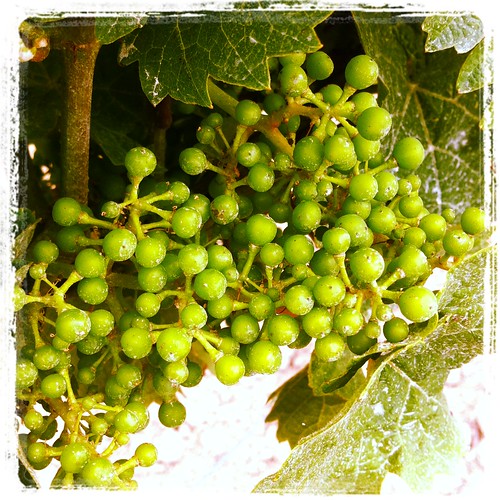
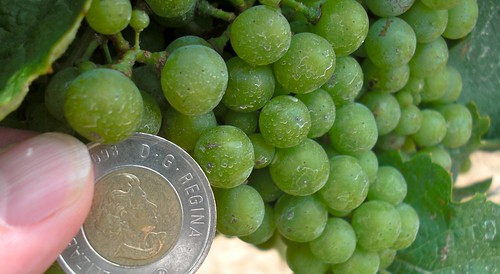
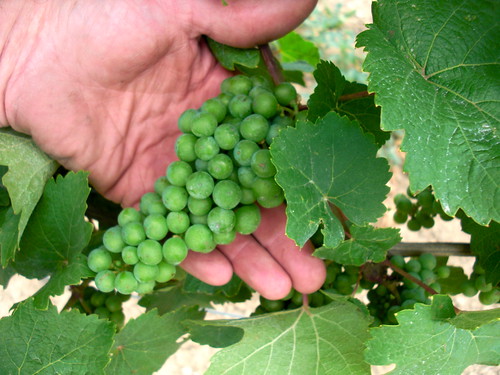
On June 13, I received the email I had been waiting for.
“Looking VERY happy in the sun. We have been busy lifting wires and tucking shoots this week. Oh YA. And flowering is pushing full steam ahead.”
Like a proud papa, Schmidt could hardly contain his excitement. And the photo attached to his email confirmed it in the subject line of his message: FLOWER POWER!
Flowering is the next big step in the life of Grape X (which really isn’t a grape at all at this point).
When last we checked in on Grape X, our vine was just going through bud break. The weather for the previous month, a combination of heat spikes and bouts of rain, had kept Grape X on the fast track for development.
Everything was ahead of normal growth in Niagara by about a month and about two and half weeks ahead of 2011.
Flowering occurs anywhere from 35-75 days after bud break (in this case, 37 days) depending on temperatures.
At this point in the evolution, flower clusters start appearing on the tips of the young shoots. A few weeks after the initial clusters appear, the flowers start to grow in size with individual flowers becoming observable.
It is here that pollination and fertilization of the grapevine takes place with the result being a grape berry. Grape vines are self-pollinating and do not need bees to help with the blessed event.
During the process of fertilization, the pollen fertilizes the ovary, which produces seeds as the flower begins the transformation into a grape berry, encapsulating the seed.
Prydatkewycz expects berries to set in about two to three weeks at the pace they are on. His job now is to monitor the vineyard, adjust the wires on the trellises to keep up with the rapid growth of the vines and to start some leaf removal to allow the sun to get through to the grapes, to keep the air moving and to make sure any sprays that are used get to the heart of the vine.
He says it’s too soon to tell what kind of crop the winery can expect. Berry set will determine that.
It had been an interesting ride for Grape X, but one of the major concerns is now a distant memory — the frost that wreaked havoc on many vineyards in Niagara.
The weather since then has been ideal for grape growing with lots of heat units interspersed with moderate rain.
Schmidt said he was excited to see how the rest of the vintage unfolded.
“We have enjoyed near perfect conditions (albeit early) so far, he said. “I do expect harvest to be early this year, likely beginning by the end of August if this warm trend continues. Ahhh, wine growing, never a dull moment.”
The Long, Hot Summer
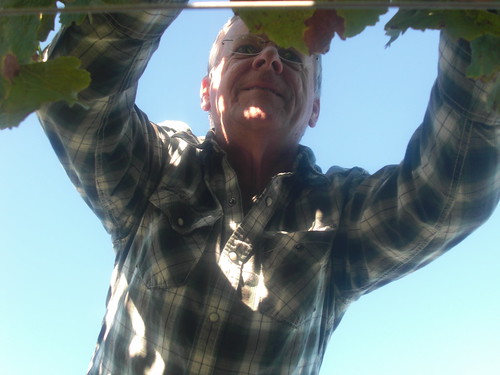
Grape X looked so fine in the beautiful bright sunlight of July.
The tiny grapes grew at an alarming rate as they headed for bunch closure, the point at which vineyard managers can no longer get inside the bunches of grapes with sprays to prevent any number of diseases that afflict vines.
I received an excited email from winemaker Schmidt in the first week of July that prompted a visit to see my little Grape X:
“Your vine is looking AMAZING. So healthy. We are now waiting for bunch closure. We are enjoying very warm dry weather which is keeping various mildew and botrytis pressures in check.”
I whipped out there, snapped a few shots, but there wasn’t much new to report, other than the weather has been ideal thus far this season and Schmidt was excited with what he’s seen thus far.
Stress in the Vineyard
By late July, the relentless heat of the long, hot summer was starting to wear on the vineyards of Niagara.
While most would assume that a prolonged heat spell would be beneficial for grape vines, it started to worry winemakers and viticulturists who were looking to the skies pleading for a good old-fashioned rainstorm.
While Grape X was in perfect health, up and down the rows you could see victims of the heat with yellowed leaves and stunted growth. It’s a combination of heat, lack of rain and the late frost that has rendered some vines useless, at least for this vintage. But, thankfully, it was only a smattering throughout the vineyard.
Harvest Looms
By mid-August, the we were well past the mid-way point for the 2012 Niagara growing season as wineries turned their full attention to the looming, yes, looming, harvest.
It’s wasn’t a stretch to predict some growers would be picking grapes for sparkling wine by the end of the month with early ripening aromatics not far behind in early September.
The 2012 grape-growing season got off to a very quick start with unusually high temperatures in the early spring followed by two frost episodes that hurt some grape buds in the peninsula, especially those without wind machines.
After that, it was smooth sailing with extremely dry and hot conditions through the summer until a brief reprieve in the second week of August with cooler, wetter weather.
The drought-like conditions were felt in most of the wine-growing areas of eastern North America, with some regions expecting half the harvest of previous years.
But the hot, dry conditions meant the potential for concentrated flavours and sugars and a reduction of pests and disease, translating into higher-quality fruit.
Schmidt was succinct in his assessment of the vintage so far when I asked him for two or three paragraphs on harvest 2012 to this point:
“Two or three paragraphs? How about two or three words? “(insert expletive here) dry. And hot. Sorry that was four words.”
Death of a Grape, Birth of a Wine
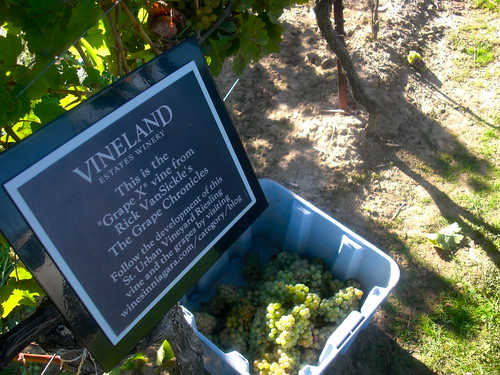
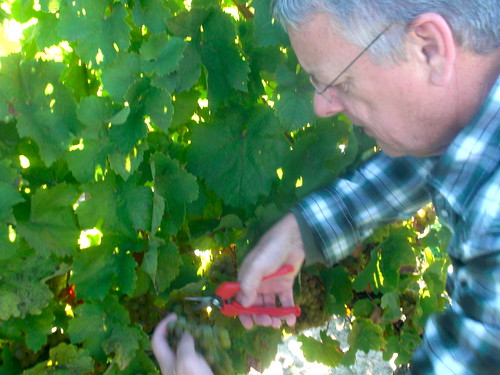
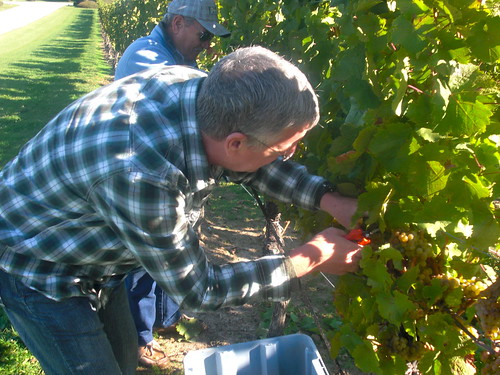
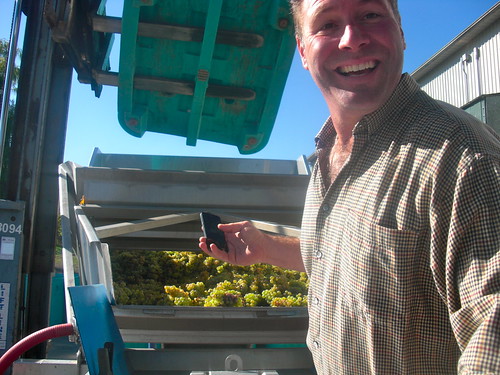
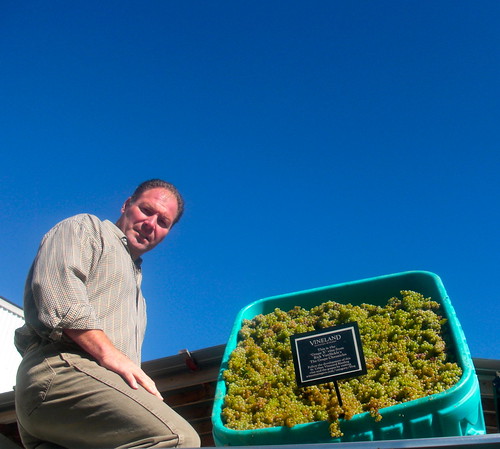
It was a picture perfect day to end the life of Grape X. On Sept. 22, with brilliant sunshine beaming down on the Niagara Escarpment, it was much like it was back on May 14 when Grape X was born.
I was invited by Schmidt and Prydatkewycz to help handpick the last few bunches of grapes from the vine that housed Grape X for the past five months. It was largely ceremonial, as the St. Urban Vineyard is mostly harvested by a mechanical harvester called the Gregoire G8. This is a tidy, efficient machine that does an excellent job picking bunches of grapes cleanly from the vines and de-stemming bunches as it goes.
I was given a quick lesson by Prydatkewycz on how to clip bunches off the vine that held Grape X.
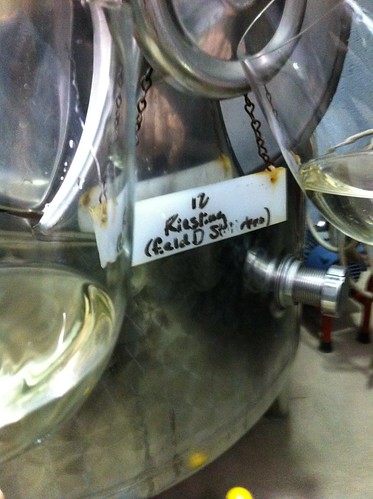

Schmidt and his team machine harvested about 10 tonnes of gorgeous Riesling from Field D, the final block to be harvested from the St. Urban Vineyard in 2012.
He has decided to vinify separately about one tonne of that, including the vine where Grape X lived and died, for a special bottling of Riesling with a slightly higher sugar content between 25 and 50 grams per litre. The grapes were picked at 19.2 Brix (a measurement of sugar content) with about 10% of the grapes forming botrytis fungus (this is a good thing). He is leaving it on the lees to give the wine more texture and complexity.
It was exciting to hand-harvest the Grape X vine and carry the grapes to the winery for processing in the receiving hopper before being crushed into juice and pumped into tanks in the winery.
Grape X was sent to a small 1,000-litre tank and will be finished in style that’s a little sweeter than the other Vineland Riesling bottlings.
I had a chance to taste the fermented Grape X juice in early December (2012) while still in tank. That beautiful little berry and all her pals were tasting mighty fine. A little sweeter, but balanced out by the natural acidity of the famed St. Urban Vineyard. Schmidt said at the time he’s going to bottle Grape X, all 1,000 litres, in a special label.
I’ll be first in line to buy it when Schmidt puts it up for sale sometime this year.
Epilogue
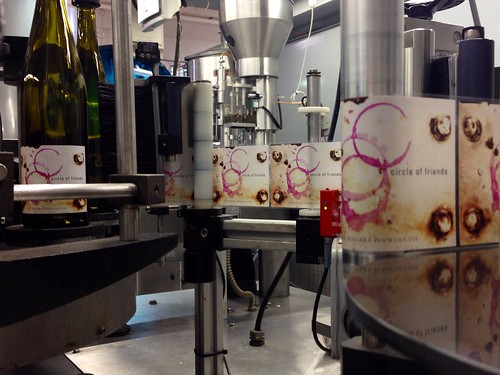
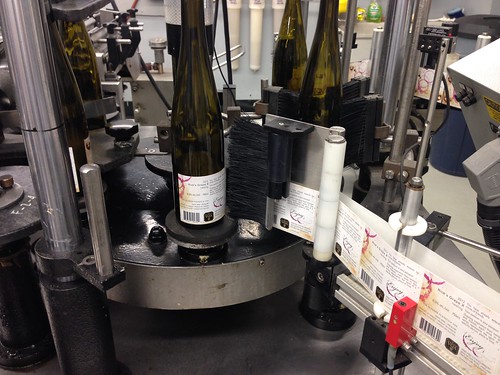
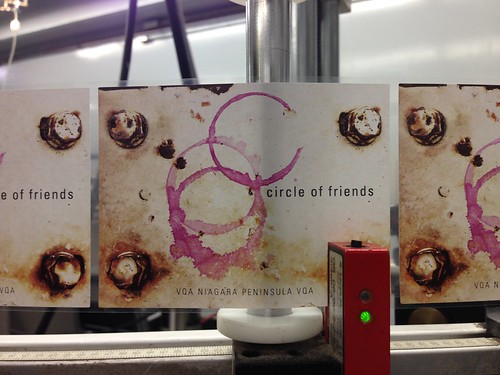
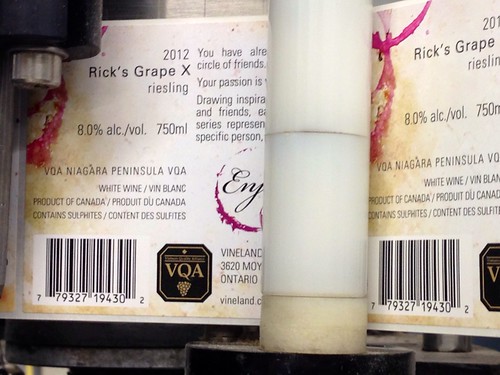

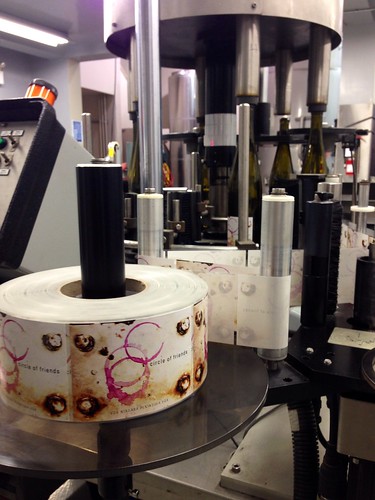

The wild ride for Grape X is over. This special wine was finally labeled last month and was sent to Vineland Estate wine club members last week.
It was exciting to see the wine labeled under Schmidt’s “Circle of Friends” tier with the words: Rick’s Grape X Riesling, printed on the back label. As soon as the bottles started arriving to members around the province, Twitter and Facebook lit up with members expressing their glee that the wine had arrived. I have included the first review of this below, by wine club member Rick Bates, but will not be reviewing the wine myself (for obvious reasons).
But I did enjoy a taste of the final, final, final wine with Schmidt on Friday at the winery.
It is exactly as I envisioned. And I am grateful to Schmidt (and for his photos above on the bottling line) and Vineland for letting me be a small part in helping making it all happen.
R.I.P., Grape X. And thank-you for the delicious legacy you have left behind.
•••
Grape X In Review
By Rick Bates
In 2012 wine writer Rick VanSickle decided to chronicle a Riesling grape from birth to Bottle. Known as Grape X, it was grown in the famed St. Urban Vineyard at Vineland Estates Winery (on the Beamsville Bench). About a tonne from Block D was vinified separately and eventually became what was bottled under Vineland’s Circle of Friends label and distributed to their Connections Wine Club members.
I followed Rick’s articles about the life of Grape X and even went there and visited it once, so it was with great anticipation that I opened my bottle of it when my March wine club package arrived.
Vineland Estates Circle of Friends Grape X Riesling 2012 (Only available to Vineland Estates wine club members, 89 points) — The nose was thick with fresh green apple, a hint of pear and orange rind flavours. I also got pleasant wet stone or limestone mineral aromas with a hint of cinnamon or clove. This combination of aromas instantly gave away its birthplace on the Beamsville Bench. In the mouth there were flavours of lemon, pineapple and limestone. The sugar in this wine is slightly higher than most, but it’s more than balanced by the high acidity. These two aspects are not fully integrated yet, but I imagine they will be further as this wine ages. With all that sugar and high acidity, I can see this wine improving to my liking over the next 3-5 years. This is a light bodied wine, easily sipped on its own, but I would pair it with mildly spiced Asian dishes, or pan seared white fish.
I gave this wine a 4 out of 5 stars on my “Did I like it scale” and gave it 89 points.
• Bates is a long time Ontario wine supporter and fledgling wine writer






Comment here